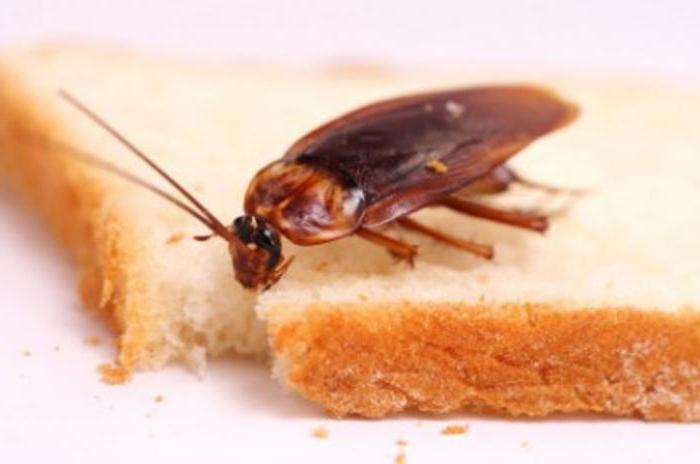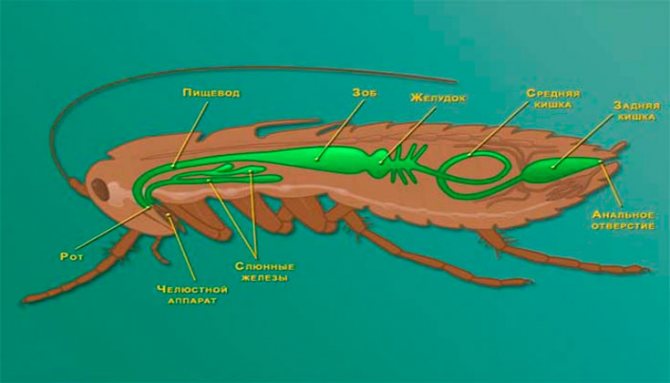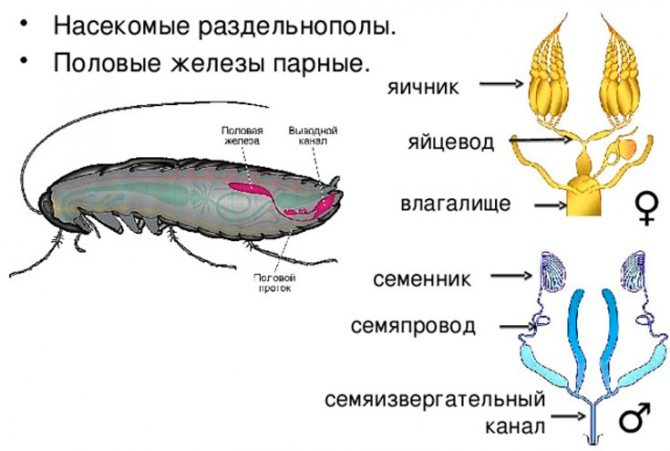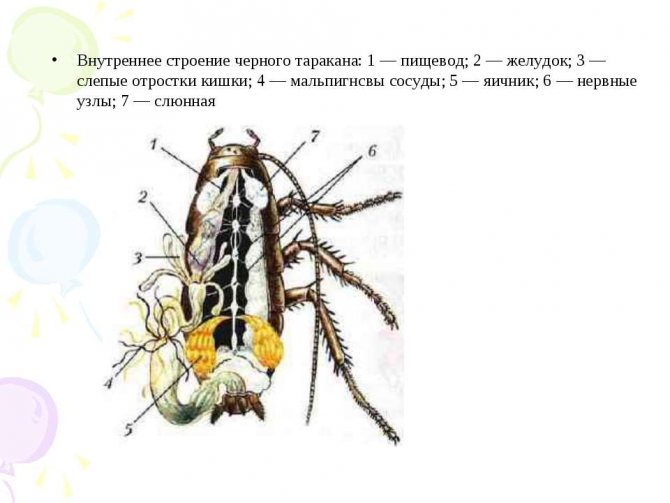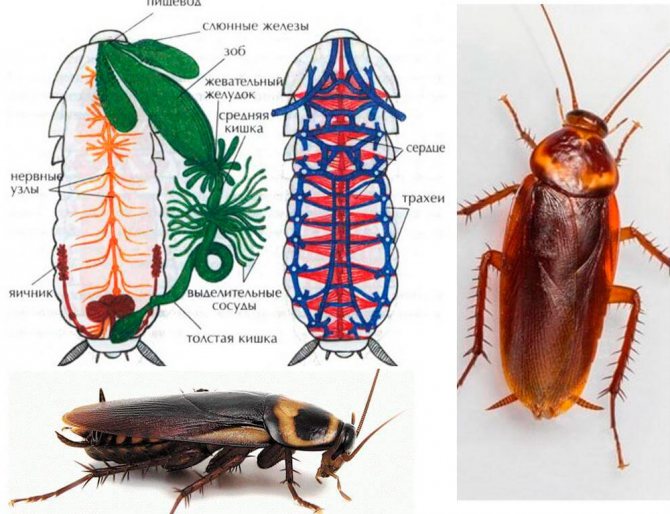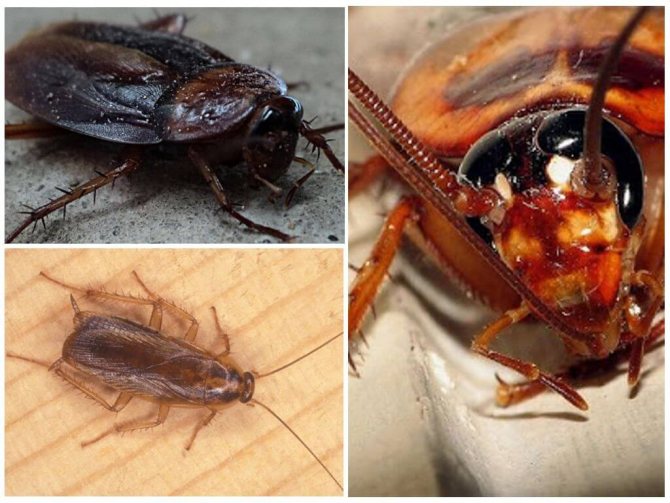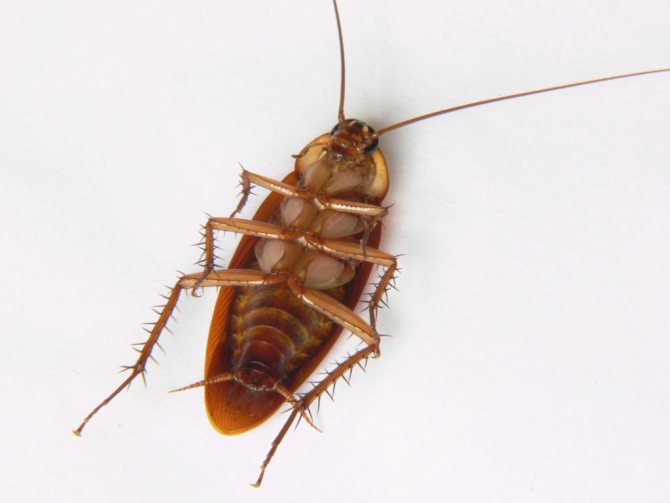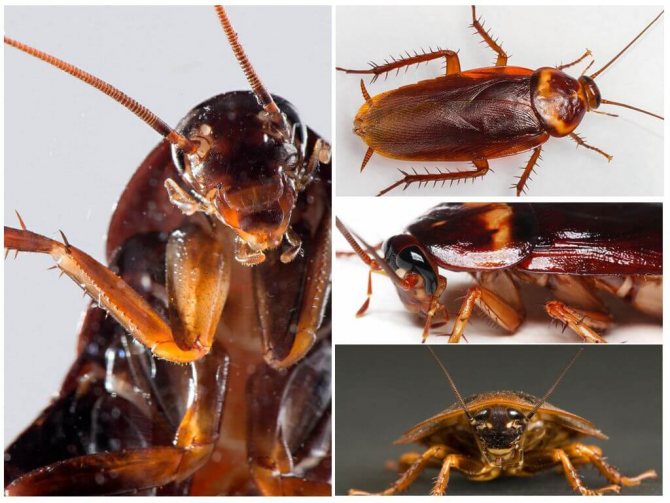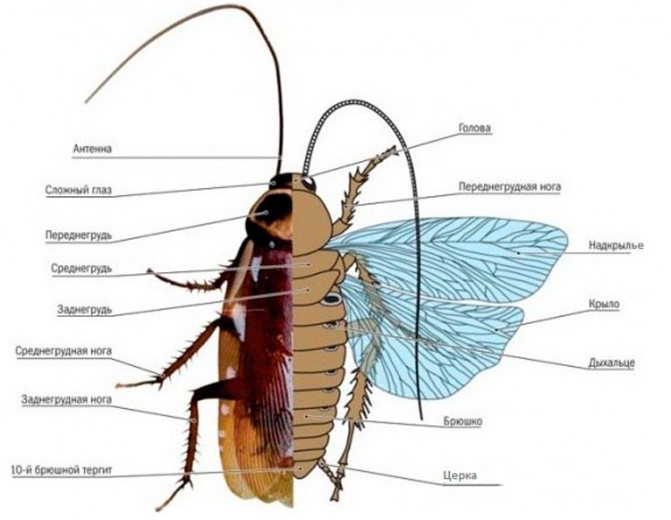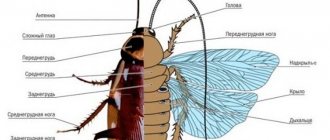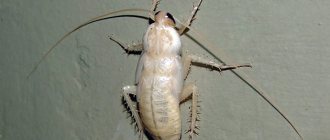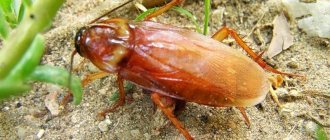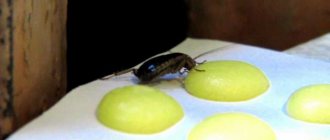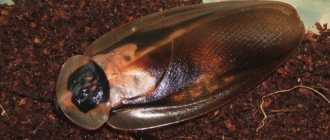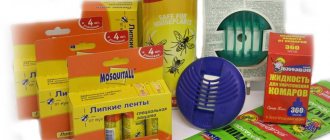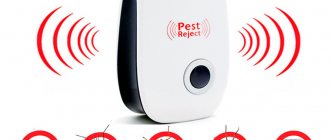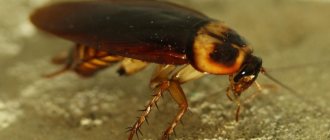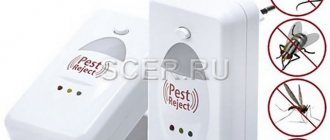An arthropod colony burrowing in the substrate is a typical picture of modern rainforests. Cockroach insects are the oldest representatives of new-winged animals with incomplete transformation. Over the years of evolution, they have not undergone major changes. Arthropods have become true cosmopolitans, spreading across all continents except Antarctica. Cockroaches are hardy and agile, shy and omnivorous. Some species have become synanthropic insects.
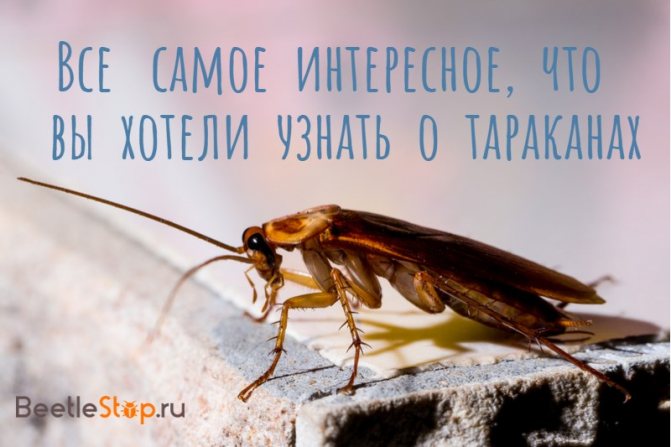
Interesting Facts
- Tsar Peter the Great was terrified of cockroaches.
- Some representatives of this order of insects are used in rather exotic activities - cockroach races.
- Sugar-coated cockroaches are one of the traditional Chinese dishes.
- A cockroach can live up to nine days without a head.
- If desired, this insect can regrow lost limbs.
- The female cockroach lays about two million eggs per year.
- If the cockroach rolls over with its feet up, then it will not have very many chances to return to its original position.
- These amazing insects can hold their breath for 30-40 minutes.
- Every 15 minutes, cockroaches release gases, which contribute to the global warming of our planet.
Due to the fact that black cockroaches have been known to mankind for more than 3 centuries, various beliefs and unusual facts associated with these insects have appeared at different times. For example, in the old days, cockroaches often hid behind a warm stove, which is why they began to be called "baked inhabitants".
There was also a legend that the appearance of black barbel in the house promised wealth to the owners, so they were even fed and taken with them when moving to new housing. Ancient healers prepared a healing potion from cockroaches, used for digestive disorders. It consisted of garlic and insects fried in oil.
In Asian countries such as Thailand, South Korea, Cambodia and Vietnam, cockroaches are still considered an indispensable component of many national dishes. They are eaten fried, stewed and dried, and are also offered to all tourists to try. Such food addictions are explained by the high content of high-quality protein in the body of insects.
Scientists entomologists, in the process of many years of studying various insects, discovered an interesting fact that cockroaches are not affected by radiation, due to their slowed down biological processes.
According to archaeological excavations, cockroaches appeared during the period of the dinosaurs and reached sizes of 50 cm in length and more. Modern data confirm another fact - cockroaches are able to feel the approach of heavy rain, which is why they diligently rush to hide even at night.
The life of cockroaches is inextricably linked with human life, which is why there are frequent cases of the appearance of dreams with the participation of these insects. To understand what black cockroaches dream about, one should turn to specialized interpreter books.
For the most part, such dreams report joyful events, success in business and well-being (even if there were a lot of insects, and they attacked a person).
Advice
- If you are faced with a cockroach infestation, a very thorough and full-scale pest control should be carried out.If you do not process at least one zone, cockroaches will survive on it and fill your house again.
- Furniture cockroaches often hide in warm places, such as the top shelves of cabinets.
- If you have cockroaches, it is highly recommended to store food in airtight containers or containers to avoid contamination or contamination. The same goes for garbage.
- Black cockroaches like to hide in or near drains, pipes, and dark, cool places.
- Prusaks mainly live in places where food is prepared, that is, kitchens.
We offer you to familiarize yourself with the Best cockroach remedy of 2020: an overview of the 12 best drugs
External features of a cockroach
The structure and general characteristics of the cockroach are almost the same for all representatives.
Almost all cockroaches differ in the oval shape of their body. As for the head of this insect, it comes in two forms - triangular and heart-shaped. On its sides are two long antennae, the so-called antennae, as well as two compound eyes, with the exception of the structure of cave species.
Cockroaches have a fairly strong oral apparatus, which is one of the gnawers, as well as two wings consisting of the elytra and the wing itself. A distinctive sexual feature is that the female hides an egg cocoon inside the abdomen, and the males have a genital plate at the end of the body.
The back of cockroaches is covered with a shell, under which there are two wings, but they cannot fly with their help, only glide when falling. Of all the existing species, there are wingless and flying species.
As for the internal structure of cockroaches, the respiratory, digestive and blood supply organs are of particular interest.
As for the digestive system of these parasites, it begins with the oral cavity, followed by the subglott and salivary glands. Saliva has a very important role, since it is thanks to it that food is wetted.
Despite the fact that cockroaches have wings, they do not use them for their intended purpose. Insects use this part of their body in order to significantly slow down a fall at the time of gliding from a height, as well as to develop speed while running. Among other things, the wings are used by males in order to demonstrate to the female that they are ready for intercourse.
As for how many paws a cockroach has, then all varieties of parasites have six of them, paws are located on both sides of the chest.
Cockroach structure
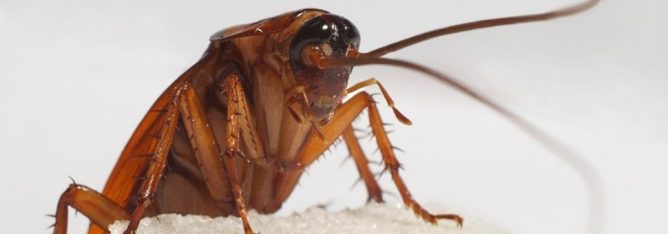

Each pair of limbs in a cockroach performs its own specific functions, which are as follows:
- the forelimbs play the role of brakes and differ in that they are much shorter than all the others;
- the middle limbs serve to provide the insect with maneuverability, and also allow these parasites to move in different directions;
- the hind limbs are the longest and act as a kind of pushing mechanism.
As already noted, the cockroach is an easily recognizable insect. Its body is elongated in the direction from the head to the back and is segmented into several sections. Colors - from dark brown to reddish brown, it is to this color that we are accustomed, observing pests in our apartment.
The outer shell of the insect, dense and tough, composed of calcareous layers called sclerites. In total, ten such segments are distinguished, which are equally distributed on the dorsal and abdominal parts of the insect. The segments on the dorsal side, or noteum, are called tergum, and on the ventral side, the sternum.
The chitinous cover is covered with wax on the outside, which is impervious to water. It protects the body from moisture loss and provides rigidity to maintain the anatomical shape of the insect's body, as well as a surface for muscle attachment.Neighboring segments are interconnected by a thin, soft and flexible membrane, in a word, those are still knights in armor.
The front wings are mesothoracial, they are also called elytra. They cover the entire chest region of the body and part of the abdominal cavity. The hind wings are located slightly lower than the front ones. Both pairs perform exclusively protective functions. To date, no red cockroach has been observed to fly, although anatomically and physiologically this is quite possible.
Description
In nature, the Madagascar cockroach lives in the rainforests of Madagascar. Thus, insects are endemic to the island, their range is limited only by its territory. It is a large insect weighing up to 60 grams and up to 90 mm long. In nature, it lives on tree branches and on the ground, hiding under a layer of fallen leaves, bark, branches and other plant debris. Prefers places with high humidity. It feeds on the remains of decaying fruits, berries, plants, mushrooms and other decaying vegetation.
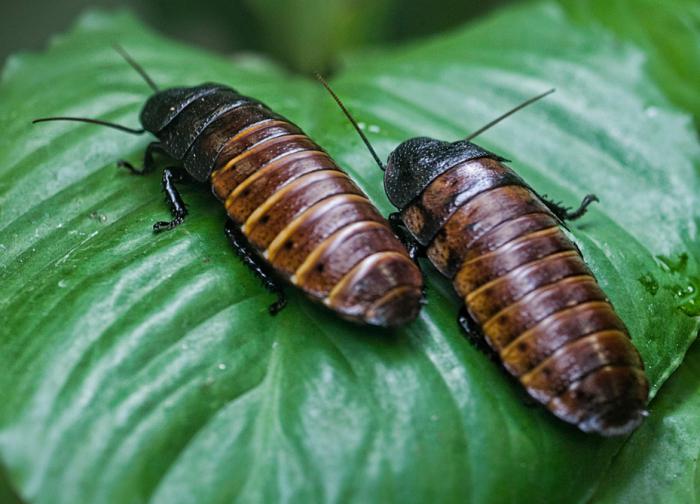

The Madagascar hissing cockroach has no wings. Its body is covered with a strong carapace, the color of which can vary from light brown to black. Females are larger than males. Males are distinguished from females by the presence of two conical protrusions, similar to small horns. An additional distinguishing feature may be the condition of the mustache. In females, whiskers are intact and even, and in males - damaged and even partially torn off. The reason for this is the constant struggle of males among themselves for females.
How many legs do cockroaches of different species have?
The Madagascar cockroach remains exotic enough for the inhabitant of traditional multi-storey buildings. It is not found in ordinary human dwellings. Most often it can be seen at various entomological exhibitions. Having seen such a creature, children often ask how many legs a Madagascar cockroach has. The fact is that its abdomen is very large and it is not always possible to see the number of limbs behind it. Nevertheless, like all of its counterparts, the number of legs does not differ and is equal to six.
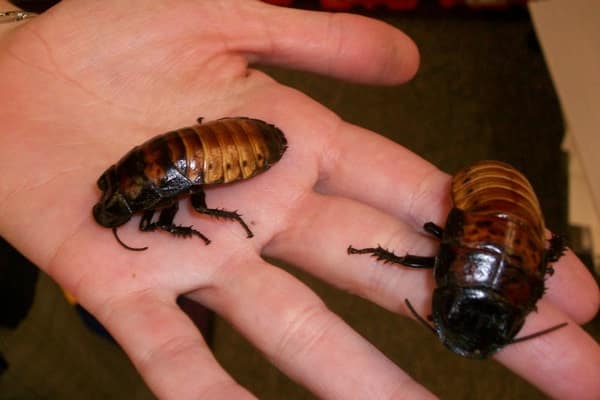

This cockroach species is impressive in size. Some individuals reach 8-9 cm. An additional property of the insect is the ability to make a sound similar to hissing. It is seen as a defense mechanism and a way to attract the female for fertilization.
The legs of a cockroach from Madagascar are relatively small in relation to its body. They must withstand a large mass, so their segments have well-developed muscles. With their help, he can quickly move and crawl onto different surfaces.
This is due to the common origin of insects with similar developmental principles. The only thing that may differ is the strength and size of the respective body parts. This fact practically does not affect the very problem of the invasion of Prusaks in the apartment, but it can be of particular interest to individual entomologists and insect lovers.
If you are interested in taking a closer look at the structure of the cockroach, it is most clearly to do this with Madagascar individuals:
Classification
The order Cockroach (Blattopera) belongs to the class of insects, type of arthropods. Termites are included in the vast group of 7,570 species. Cockroaches are representatives of the superorder of cockroaches (Dictyoptera). It includes new-winged insects with incomplete transformation. In the world, 4640 species of cockroaches have been found and studied. There is a constant debate among scientists about taxonomy. The authors divide cockroaches into different numbers of families and subfamilies, classify them together and separately with termites.
According to the latest data, 8 families have been identified: Nocticolidae, Corydiidae, Blaberidae, Ectobiidae, Cryptocercidae, Tryonicidae, lamproblattidae, Blattidae. The greatest variety of species is found in the tropics. Insects found an abundance of food and shelter in warm and humid forests. On the territory of the CIS, 55 species of cockroaches live.Some of them are synanthropic, living next to a person.
Information. Is a cockroach an insect or an animal? In everyday mention, animals are called four-legged vertebrates, but in the scientific classification they include many organisms. Insects are arthropod invertebrates.
Limbs of cockroaches
If you look closely at the structure of the cockroach, you will notice that its paired legs are separated from the body. At the same time, they are able to move with the help of muscle-type strength.
How many legs does this insect have? Now it is reliably known that all representatives of this species of insects have six legs.
How many legs are there in the thoracic region? 3 pairs of walking paws are attached to the thoracic part of the cockroach's body, with the help of which they can move.
All pairs of legs have their own name. It is determined by the name of the region of the insect's chest to which they are attached.
Pairs of cockroach paws are named as follows:
- A pair of prothoracic paws. This pair of limbs is closest to the head. These legs are the shortest. Their main function is deceleration in the process of decreasing speed, when the insect finishes running.
- A pair of paws of the middle chest type. These legs have the ability to move both backward and forward. This helps the cockroach, if necessary, to accelerate or, on the contrary, slow down its movement.
- A pair of metathoracic paws. Such legs are considered the longest in this type of insect. They are located in the back of the torso. With the help of such legs, cockroaches can move their body forward. This pair of legs is the main one in performing the walking function.
It should be noted that anatomically, the body of a cockroach is designed in such a way that all pairs of its legs differ significantly from each other in their length, as well as in their functions. Moreover, they have almost the same structure of the segmental type. They also have the same functions for flexion and extension.
How many claws do cockroaches have? At the tips of each of the legs there are several sharp claws, which allows insects to cling to surfaces of any type. This also applies to vertical walls and ceilings.
It should be noted that from the point of view of anatomy, the structure of the legs in cockroaches gives them the opportunity to develop high speeds.
As can be seen from the above, their limbs play very important functions and allow them to move in various planes at high speed. If necessary, cockroaches, using their limbs, can quickly slow down and change the direction of movement.
Why do people keep Madagascar hissing cockroaches
Madagascar cockroaches are harmless insects. They are not capable of harming a person, much less biting him. No unpleasant odors emanate from them. The hissing of insects can unnerve some people at first, but the owners quickly get used to it and even begin to get bored when the cockroaches are silent. Cockroaches cannot cause any allergies in humans. All on hissing cockroaches in some people have a nervous origin and pass without a trace as soon as a person gets used to the insect.
Keeping insects at home is fun and exciting. Some owners organize gambling cockroach races. Others simply admire them, rejoicing in their presence in the house. The Madagascar cockroach often brings a lot of income.
Cockroach farm
Some owners of exotic animals and insects, such as snakes, lizards, spiders and the like, breed hissing cockroaches as high-calorie live food for their pets. It is very convenient and profitable. One female Madagascar hissing cockroach can bring more than 750 offspring in her life.And if there are many females, then you can organize a whole farm for growing live food at home. Cockroaches grow quickly, the cost of feeding them is small, the females are very fertile, so exotic animals are provided with food for a long time. Now you know that Madagascar cockroaches can also bring profit. The content, most importantly, must be made taking into account all requirements.
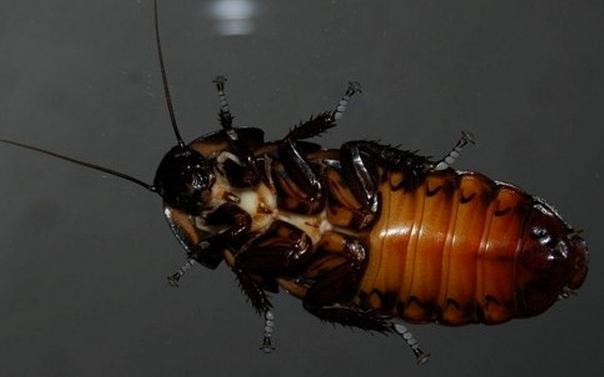

But in some countries, these insects have become a delicacy for the people themselves. For example, in Thailand, gourmets willingly order cockroach dishes and sincerely enjoy them. Cockroaches contain a lot of calories, protein and other substances useful to humans, and Madagascars taste like tender veal and chicken.
Madagascar hissing cockroaches are among the exotic animals that people breed at home. The popularity of cockroaches is increasing and the demand for them is constantly growing. In big cities, such a pet can be seen in every 50th apartment. The neighbors are not very happy with such animals, especially when the cockroaches manage to escape.
Insect limb types
The running and walking legs of insects are considered the most ancient. The remaining types of limbs appeared in the process of long development, and, as a rule, are associated with various adaptations to environmental conditions.
Running limbs
The running legs are elongated. They are slender, and the tarsus, lower leg, thigh and coxa are narrow or wide. This type of limb is present in cockroaches and ground beetles.
Walking legs
Walking legs are designed for slow movement. Such legs of beetles - longhorn beetles, leaf beetles, crawling from leaf to leaf, leisurely gnawing leaves.
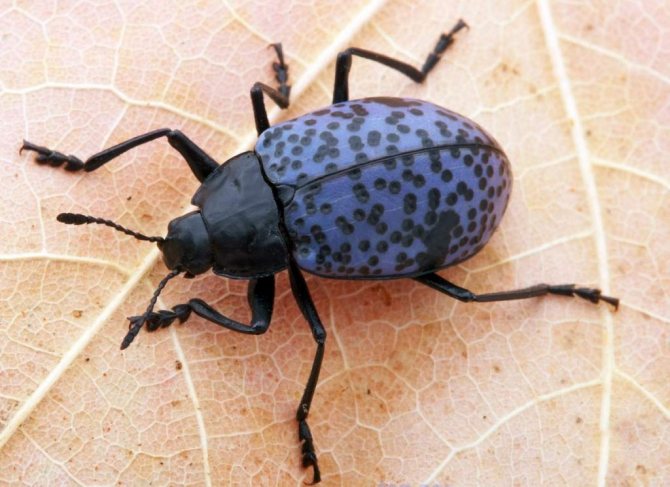

Insects need limbs to move.
Swimming limbs
Usually the hind legs, less often the middle legs of insects, become swimming. They are covered with long hairs that form a wide rowing surface - a kind of paddle. Basically, representatives with such limbs live in water bodies and swim and dive excellently. These are swimming beetles, smooth bugs, water lovers.
Jumping legs
Representatives of the order have jumping legs orthoptera. These include locusts, grasshoppers, and crickets. The last pair of legs is very long and powerful. Many representatives of Orthoptera jump up to eighty centimeters in height, and if they spread their wings, the distance covered in one jump reaches about ten meters.
Digging feet
Digging legs are characteristic of the bear, dung beetle, and may beetle. Usually the first pair of legs becomes digging. The limbs of this type are powerful, flat and short.
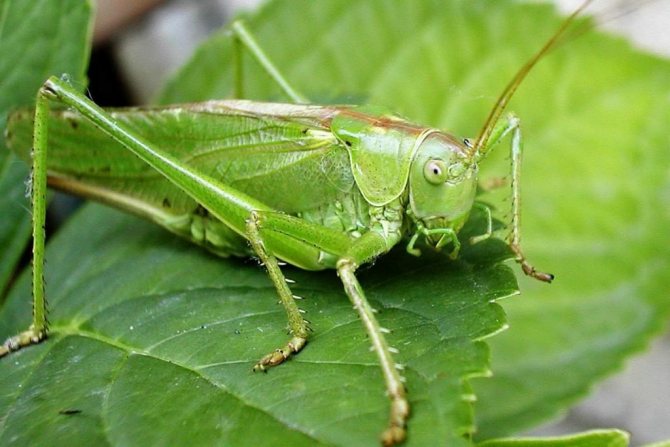

Grasshopper paws enable them to move tens of meters in a matter of seconds.
Gathering limbs
The limbs of bees and bumblebees are called collecting or basket-like. On the hind legs of these insects there are special areas surrounded by long chitinous hairs, these are the baskets. Bees move from flower to flower and get dirty in the pollen, which sticks to the hairs of the body. The bee collects pollen in baskets with special brushes located on the paws.
the adhered dust particles form a lump, which is called "obnozhka". The bee carries the pollen to the hive and deposits it in the combs. A bee bread is formed, saturated with nectar, it serves as a reserve protein feed for the entire bee family.
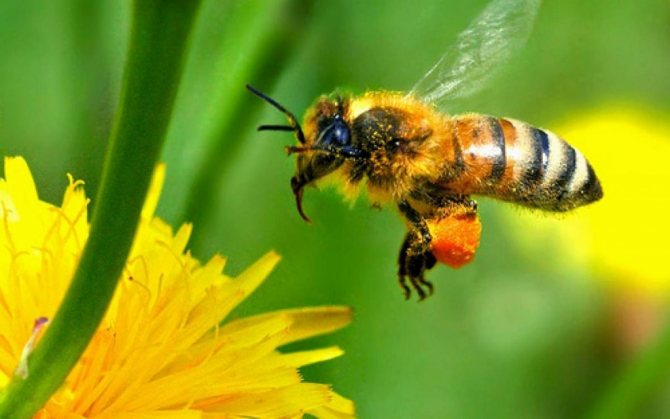

Thanks to the collecting type of legs, the bee can “accumulate” pollen.
Grasping legs
Grasping legs of the praying mantis. They are armed with sharp thorns with which the predator keeps prey.
Suction limbs
The legs of males of some species of insects - swimming beetles, ground beetles have widened segments at the ends of the legs. During the breeding season, males embrace females with these adaptations when mating.
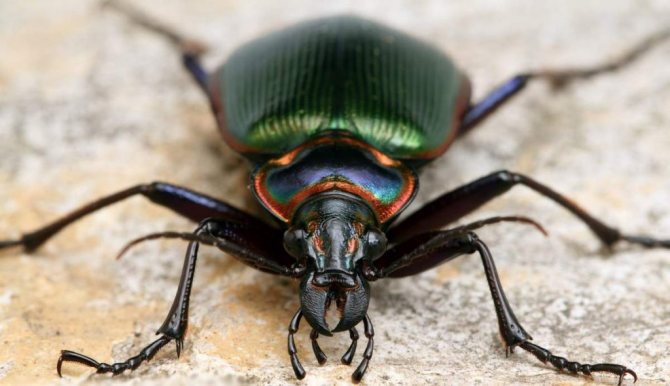

Grasping legs help not only to hold the prey, but also the female during mating.
Cardiovascular and respiratory systems
The organs of the cockroach blood system are of the open vascular and lacunar type. The body cavity contains a fluid that washes into all the insides, which is called hemolymph.
The circulatory system of blood vessels consists of a tubular heart and blood vessels, this is the anterior aorta and a system of poorly distinguished spaces, or sinuses.
The internal body cavity of the cockroach is divided by two membranous horizontal septa into three wide and flattened sinuses — the dorsal pericardium containing the “heart”, the middle perivisceral sinus containing the intestines and the ventral perineural sinus, or the thoracic sinus containing the nerve cord. The septum between the pericardium and perivisceral sinuses is called the dorsal diaphragm, and between the perivisceral and perineural sinuses, the ventral diaphragm.
The circulation of the hemolymph occurs due to the acceleration of the hemolymph by the pulsations of the "heart" and the pressure arising in the sinuses. Respiratory movements of the abdomen and muscle contractions increase this force, but the speed of blood movement is quite low.
The insect's respiratory system consists of a network of trachea, which opens outward with spiracles in the form of 10 pairs of small holes. Which are present on the side of the body of the body. Thin branching tubes (tracheal tubes, subdivided into tracheoles) carry oxygen from the air to all parts of the body. The opening of the spiracles is regulated by the sphincters. The exchange of gases in tissues occurs by diffusion.
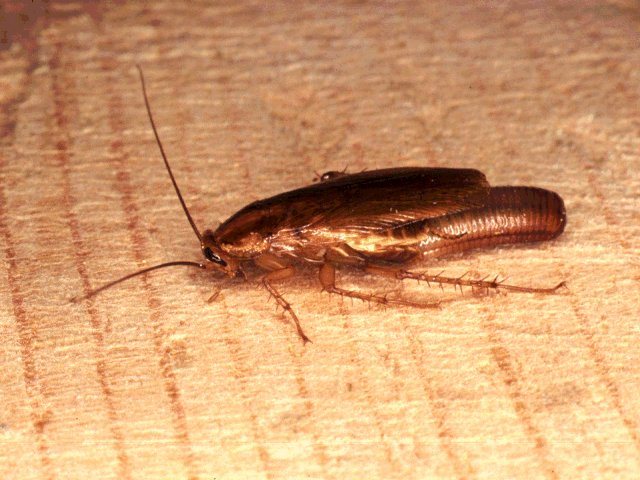

Cockroach structure
Despite the species diversity of the order, the body structure of its representatives is in many respects similar. The morphology of adults (adults) is typical. Differences appear in size and color.
External structure of a cockroach
The body of insects is flattened, oval in shape. This structure allows you to crawl into narrow cracks and holes. The length of the imago ranges from 9 to 95 mm. The color of the cover is often dark - brown, black, brown. Reddish and coffee colors are less common. Nocturnal lifestyle, secrecy and the need for camouflage do not require the presence of bright colors.
Cockroach body sections
Insects have three main divisions: head, chest, and abdomen. Dividing the body contributes to its mobility. The functional significance of each department:
The head is triangular or heart-shaped, mobile, covered from above by a pronotum shield. The organs of sight and touch are located on it. Antennae are mobile appendages consisting of segments. The type is bristle. The functions of the antennae in a cockroach: touch and smell. With the help of appendages, they determine the taste of food, find sexual partners, and contact between individuals. The oral apparatus is directed downward.
Thorax - the middle section consists of three segments, divided into tergites and sternites. The upper half rings form the back, the lower ones - the chest. The largest segment of the pronotum, it is flat and convex. Elytra and wings are attached to it. One pair of limbs belongs to each of the parts of the chest.
Abdomen - the largest section consists of 10 segments. At its end there are paired articulated appendages of the cerci. In the abdomen, the respiratory and digestive systems are located, in females the ovipositor. The anal plate is located on the 10th tergite.
Reproduction
The life cycle is divided into three forms of development: egg, nymph, imago. During the summer season, cockroaches begin to mate. Females lay their eggs in a chitinous cocoon that holds 16 eggs. In a female expecting offspring, the belly is slightly enlarged. After a few days, she hides the eggs in a place hidden from view. The incubation period lasts 44 days, and then the larvae are born - small cockroaches. Black insects live from several months to 4-5 years.
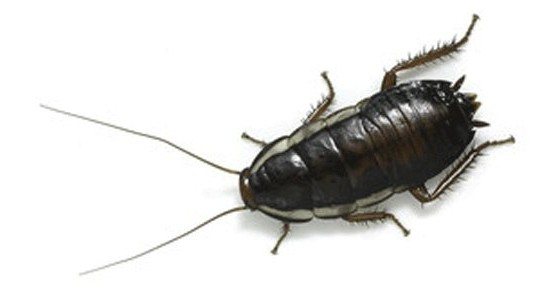

External features of the insect
The cockroach's body is elongated when viewed from the head to the back.In this case, several main body segments can be considered.
How many layers does the outer shell of an insect have? The outer shell usually consists of several layers of the calcareous type. Each of these layers is usually called sclerites by specialists. How many such segments does an insect have? At this time, a dozen of such segments are known. They are evenly distributed on the back and abdomen of the cockroach. The segments that are on the back are called tergum. The segments located on the belly of a cockroach are called the sternum.
Outside, the chitin-type cockroach cover has a waxy layer. He doesn't let him get wet. Another of the functions of such a cover is to protect the cockroach from moisture loss, which helps it maintain its anatomical shape by providing the insect with fluid. There is a surface for attaching muscles.
All these segments are connected to each other by membranes that are thin and flexible, while they are quite soft. The cockroach looks like a knight in protective armor.
- The wings located in front of the insect's body are called elytral. They usually cover the entire chest area. They also slightly affect the abdominal region.
- The rear wings are slightly lower than the front ones.
All these pairs of wings are only protective functions. There was not a single case of cockroaches flying. Moreover, the anatomical and physiological structure indicates the presence of this possibility.
General information
Black cockroaches belong to the order Blattodea, which has approximately 4,600 species. These are some of the oldest arthropods that appeared on Earth about 300 million years ago. This is evidenced by the fossils of dead ancestors, preserved in amber millions of years ago.
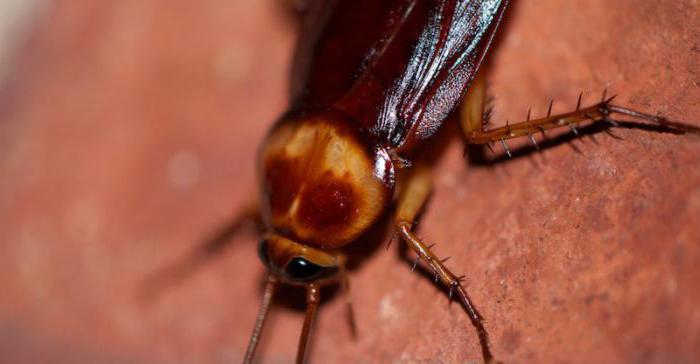

Cockroaches from distant ancestors have inherited such a trait as photophobia. Insects are nocturnal. Large black cockroaches, which number about 1 thousand individuals, eat 9.5 kg of food within one year, but they simply stain much more food. As soon as darkness falls, insects go in search of food: for crumbs of bread, pieces of vegetables, particles of granulated sugar. Cockroaches also love to feast on skin creams, laundry soap, shoe wax and ink.
White
You can often see a white cockroach in the apartment. You don't need to think that this is some kind of strange new species. In most cases, the cockroach has a white tint after molting. In their entire life, insects of this family shed their chitinous shell almost 10 times.
White cockroach
The light, almost transparent color makes it much more difficult to detect the insect. After a while, it will be covered with a new shell and acquire a permanent color. How long will it take for him to do this? Within two weeks, the mustachioed white cockroach will turn into an ordinary red or black pest.
Chemical preparations can affect the shade of the mustachioed inhabitants of the apartment. This happens especially often if substandard means for the destruction of domestic insects were purchased. After a while, the natural color will return.
Food
In natural conditions, most cockroaches are vegetarians, they eat fallen leaves, fruits, dead plants. Some species are omnivorous, their diet is expanded with the remains and excrement of animals. Domestic insects feed on any food found in the apartment. Preference is given to sweets, breads and pastries, as well as fruits. You will learn about the diet of domestic pests in the material "What do cockroaches eat: what diet to make at home?"
Digestive system
Cockroaches have highly developed organs of the digestive system, which allows them to digest and assimilate a large, often protein-carbohydrate feed.The alimentary canal is quite long and has several loops and is divided into the following sections:
- The anterior gut - the stomadeum, in turn, differentiates into several parts: the buccal chamber, the pharynx and the esophagus
- The cheek area has muscle tissue and is internally equipped with six teeth, which are used to chew food.
- The stomodeal valve, or sphincter, is present between the pharynx and the mesenterone.
- The middle intestine is mesenterone, or ventricle, short, tubular, lined with glandular endoderm.
- At the anterior end of mesenterone, there are eight blind glandular hepatic papillae that secrete digestive enzymes.
- The intestinal part - the proctodeum, contains the ileum, colon and rectum.
- The rectal wall is equipped with six rectal papillae. They help in the absorption of water and salts.
- The cockroach is an omnivorous living creature that feeds on almost all types of organic waste.
- Digestive enzymes of saliva, mainly zymase and amylase.
- Most of the nutrients in the feed are digested in the intestinal tract.
- Absorption of digested food nutrients occurs in mesenterone.
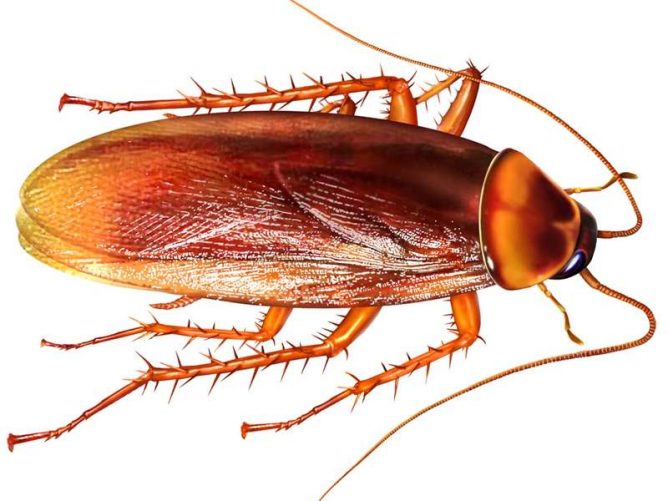

Such different legs
The world around was changing, insects were also reborn. Adapting to new environmental factors, arthropods, one might say, modified, reshaped their own lifestyle. Therefore, everyone's limbs are different - it all depends on the place and living conditions. Usually, arthropods have two pairs of legs - normal, and one - special, necessary for survival. So, what are the paws:
- Walkers are strong, unable to develop high speed, necessary for unhurried movement (leaf beetle).
- Runners are simple in structure, long and light, in order to develop the maximum possible speed when moving (cockroaches, ground beetles).
- Swimming - hind ones, with fine hairs that help to stay on the water and can contribute to a shallow dive (bedbug, water strider).
- Digging - the first pair, powerful, short, stocky and flattened (dung beetle, bear).
- Gathering - the back pair with long sticky hairs that serve as a basket (bumblebee, bee).
- Grasping - sharp, spiked, strong, serve to hold prey (praying mantis).
- Sucking - a rear pair with a slight extension at the end, necessary for holding the female during mating (swimming beetle).
- Jumping ones - high, strong, necessary in order to make a push (grasshopper).
Insect feet are the most important, vital tool. With the help of their paws, they scrupulously clean their antenna horns, wipe their eyes (this is how butterflies do), defend themselves from enemies and suddenly attack. And now it is worth considering with several examples - what legs are, and how representatives of the arthropod class use them. Scroll down below.
How many paws does a cockroach have
During molting, a cockroach can lose one of its precious limbs, but this happens quite rarely, and after a certain period of time the leg grows back. Also, the cockroach (males) have wings on the back, but the insect never uses them. It can be considered a useless gift from ancient ancestors. The legs of a cockroach are walking (what this means, we have already described above), and each pair of limbs has its own special name:
- Prothoracic - the shortest pair, necessary for quick braking during rapid movement.
- Mid-pectoral - A pair that can swing back and forth, acting as accelerators and retarders when moving.
- The posterior thoracic is the pair that coordinates movement.
Also on the legs of the cockroach there are sharp claws that allow you to crawl along walls, ceilings, cabinet doors, etc.For a cockroach, its limbs are even more important than its own head (without which, by the way, an insect can live for a month). In addition to movement, the legs help to wash, brush, jump and gain speed.
... Front pair
What are the legs of a dragonfly
The dragonfly, which everyone often hears rather than sees (after all, the insect flies so fast and noisy that it can be difficult to notice it), also has unusual legs. It would seem that strong, elongated wings, which provide the dragonfly with chic speed, are all that a charming representative of the fauna needs. However, the legs of the insect are not simple - peculiar coarse bristles are located on the front pair of limbs. When flying, the dragonfly places its paws so deftly that the bristles form a net-trap for sweet prey.
Tiny insects, having fallen into such a trap (a net of bristles), instantly become a dragonfly's supper.
Redheads (Blattella germanica)
If we consider the types of domestic cockroaches, then this is the most popular family. It is also known as the Prussians. No living space is immune to the appearance of red cockroaches.
Varieties of cockroaches
You can meet red cockroaches almost everywhere:
- Living spaces;
- hospitals;
- public places;
- utility rooms;
- country houses.
The body of the cockroach is slightly elongated, the chitinous shell has a reddish tint, which can range from light to very dark. Representatives of such an interesting family live near a large amount of food. Incredibly, they easily manage to penetrate even closed containers.
Types of red cockroaches
Interesting facts from the life of red cockroaches - they can find food almost everywhere. Even if you diligently hide all the remnants of food, insects can easily find a few grains of sugar spilled a long time ago or stale bread crumbs.
Nervous system
The structure of the nervous system of a cockroach:
- Central nervous system.
- Peripheral nervous system.
- The sympathetic, or visceral, nervous system.
The organs of the central nervous system are organized from the brain, although it would be more correct to call it - the supra esophageal ganglion. The brain gives off a pair of short, thick trunks in the form of pharyngeal ligaments that surround the esophagus and extend down and back over to the subpharyngeal ganglion below the esophagus.
From here, the nerve continues to the chest in the form of a double ventral nerve trunk, which carries three ganglia in the chest and six in the abdominal cavity.
The sympathetic or stomatogastric visceral nervous system is represented by the frontal ganglion, which is located on the dorsal (upper) side of the esophagus in the head region. From this ganglion leaves the middle unpaired recurrent nerve, reaching the visceral ganglion, located in the intestinal region. It is due to the fact that the head ganglion, which plays the role of the brain, does not play the main regulatory role in maintaining vital functions, when the head of a cockroach is removed, its body still lives for several days.
Organs of sensory structures:
- Tigmoreceptors are receptors for touch. There are a lot of them on the body, antennae, palps and legs.
- The olfactory receptors serve the cockroach to evaluate various odors. They are present on the antennae and forelimbs.
- Taste receptors that evaluate the taste of the food. Taste buds are present on the jaws and palps.
- Thermoreceptors detect changes in ambient temperature. There are a lot of them on the platforms between the pairs of limbs and the abdominal part of the body.
- Cockroaches also have auditory receptors, with the help of which they are able to distinguish a fairly wide range of wavelengths. Oddly enough, it is located in the anal cerci.
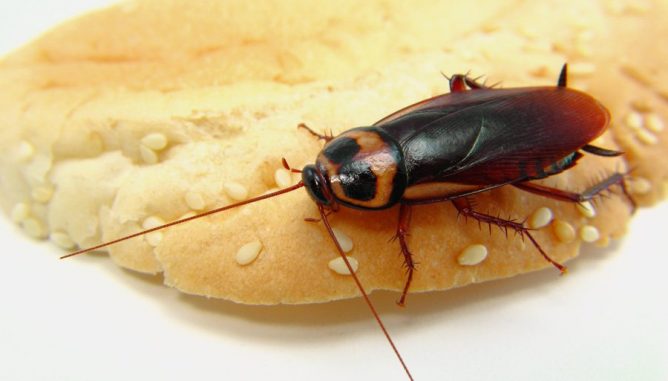

Oral apparatus
In the lower part of the head there is a mouth opening, which is surrounded by auxiliary organs, which consist of a labrum, a pair of jaws, a lower lip, and a hypopharynx. The cockroach's mouth area has a complex functionality and is used exclusively for biting off and chewing food particles. Each of the organs of the oral apparatus performs its own functions:
- The labrum is a wide, flattened plate of sclerite, running along the dorsal side of the head capsule, movably articulated with the upper jaw and acting as the upper lip. The labrum has a "nasopharynx" (chemoreceptors) on its inner side.
- Mandibles, or lower jaws. Thick, rigid and triangular appendages under the lip, on each side of the mouth, which carry sharp, teeth called denticles.
- The maxillae, or upper jaw, is located on each side of the mouth, above the madibula, and is primarily used for grinding food particles and chewing. Maxillae also carry olfactory receptors.
- The lower lip and second maxilla are fused together to form one large structure that surrounds the mouth opening on the ventral side, hence why it is called the "lower lip" or labium. Tactile and gustatory sensory hairs are also located here.
- Laryngopharynx. It is a small, cylindrical mouth organ located between the jaws and covered with a lip on the dorsal and ventral sides. It carries several sensory hairs at its free end, as well as the outlet of the common salivary canal on its basal surface.
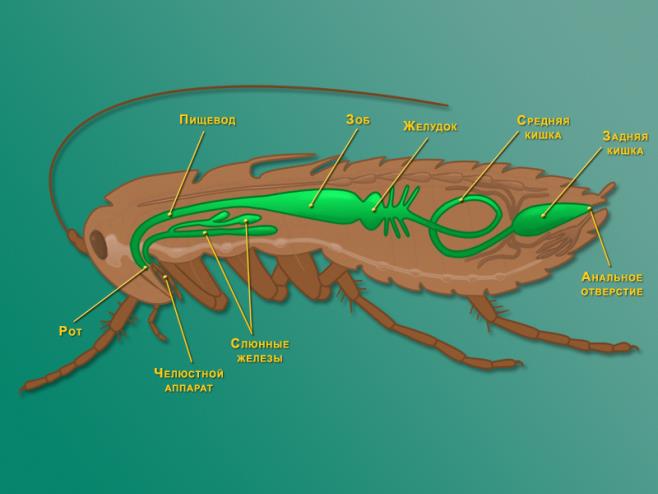

How to get rid of
People who first encountered insects in their homes always ask themselves: "Where do black cockroaches come from?" There may be several options:
- crawled from neighbors or from the basement, especially when there is a chemical fight against insects;
- brought with things from friends, relatives or from a trip a sexually mature fertilized female;
- left over from past unscrupulous tenants;
- they brought an ooteca with eggs from the entrance to the shoe.
How to get rid of black cockroaches - five proven methods:
Call specialists in chemical pest control to treat all places where black cockroaches can stay. This method is the fastest and most effective, but it requires the temporary relocation of all family members to other housing, including pets. Cool the room strongly for several days (this method is permissible in winter at sub-zero temperatures and will only get rid of adult insects, but will not protect against the subsequent emergence of young animals from the deposited cocoons). Accordingly, the flow of cold air should be long-term, which will require a change in the place of housing for all households and house plants.
Purchase a suitable insecticidal agent for black cockroaches (when buying, you should pay attention to the instructions, contraindications and study the permissibility of using it in a house with pets and small children)
Types of industrial products:
- Trap houses (for large insects) contain intestinal poisonous bait that kills adult cockroaches and nymphs.
- Gels are highly effective semi-liquid consistency products that are attractive to all types of cockroaches, since they contain water and food at the same time (mixed with poisonous components).
- Sprays are a convenient tool for treating insect clusters in corners and narrow crevices, instantly killing several dozen individuals.
- Crayons and powders (dusts) of contact action (the poison is carried on the legs of cockroaches and destroys all stages of development. Efficiency depends on the concentration of active components, most often powders give a positive result with a small number of cockroaches.
- Take advantage of modern technologies:
- An ultrasonic repeller works on the principle of affecting the sensory organs of black cockroaches (with light and high-frequency waves), exciting the nervous system, which makes them leave this dwelling.
- The electronic trap destroys the insects that come to the bait with a discharge of current. They need to be installed in several pieces, as well as to restrict access to them for pets (especially small rodents).
- Use folk methods of struggle:
- Boric acid balls (the most effective method requiring preparation). This bait is made from favorite cockroach products mixed with pharmaceutical boric acid. A well-known recipe for balls: boil 1 chicken egg and potatoes, mix them with flour and vegetable oil, adding boric acid (all proportions are taken by eye). From the resulting mass, mold small balls the size of a hazelnut kernel and arrange them in places where unwanted guests often appear. Cockroaches perfectly eat the treat, not noticing the medicinal component in it, and in the end it kills them. This product is completely safe for pets.
- Unfolding fresh bay leaves that insects don't like the scent.
- Making paper tape traps. Small houses are glued to the cockroach and they cannot get out, dying of hunger.
Uninvited guests
The structural features of cockroaches and physiology determine their favorite habitat - human dwelling. There are all the comfortable conditions here: warmth, water and darkness.
A feature of the structure of the squad of cockroaches is their omnivorousness. Their favorite treats are bread, sugar, cereals, vegetables and fruits. But if these foods cannot be included in the diet, cockroaches can eat paper, textiles, glue, book bindings, any garbage. Moreover, the parasites do not completely eat the product, but bite it and look for something tastier.
Getting rid of cockroaches is often quite difficult. They are hammered into the smallest crevices, cracks, cavities in wallpaper or ceramic tiles. Therefore, all hard-to-reach places will have to be treated with chemicals.
